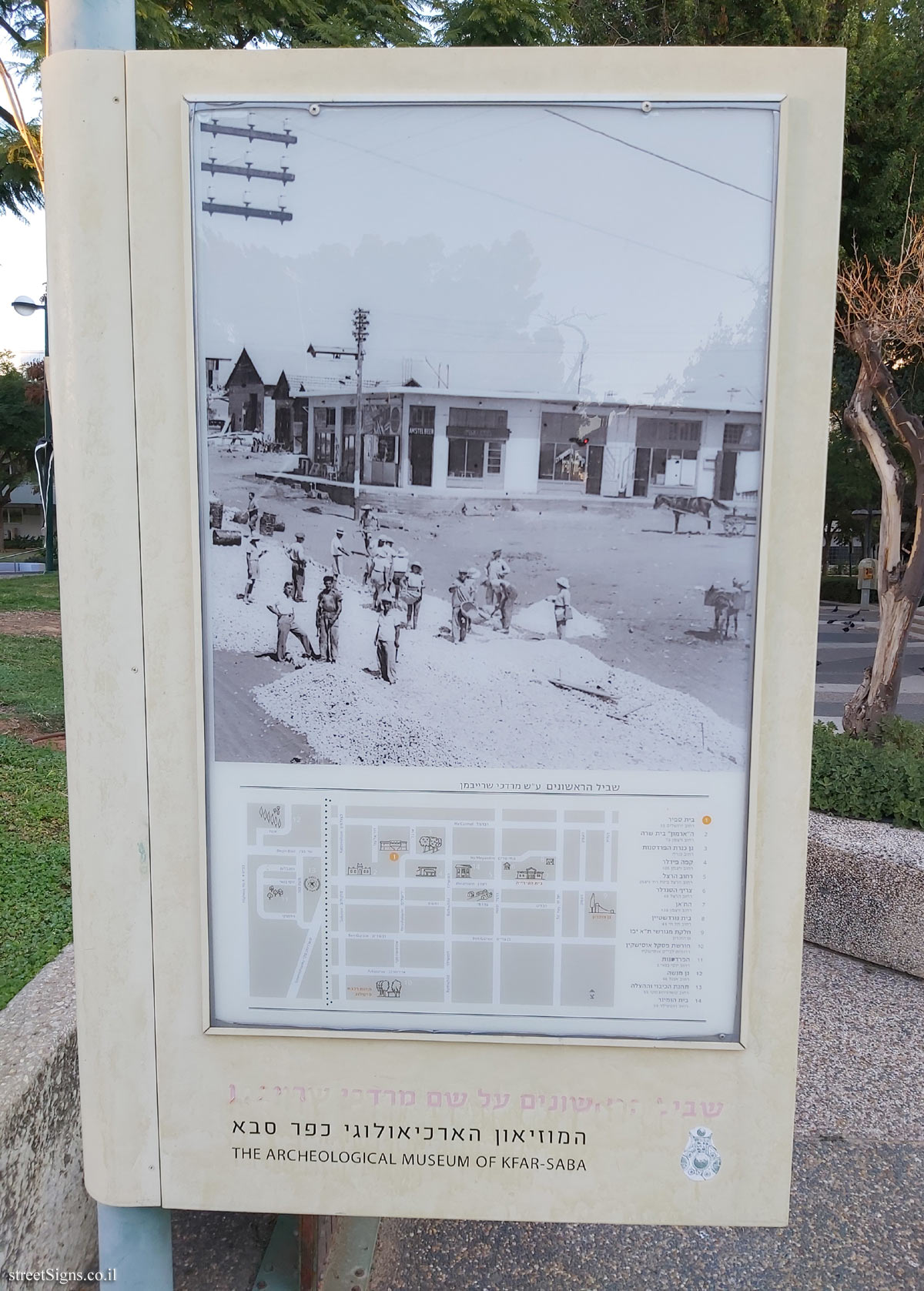On the sign:
[תמונה: ילדים ממתינים לתיקון נעליהם, ושלט הסנדלריה]
[מפת השביל]
[הצד השני של השלט]
צריף הסנדלר - אורטופד יהושע הוכמן
The Shoemaker Shack
בצריף, בו שכנה הסנדלרייה של הסנדלר - אורטופד יהושע הוכמן , מוצגת מלאכת הסנדלרות כפי שנהגה במושבה מאמצע המאה ה - 20 ועד סופה. יהושע בן פרץ ודוזה הוכמן, נולד בשנת 1906 בעיירה פיאסקי שבחבל לובלין, עם גיוסו של אביו לצבא הצאר הרוסי במלחמת העולם הראשונה (1918 - 1914) , נאלץ יהושע בן השמונה לעזוב את לימודיו בחדר ולהרתם לפרנסת המשפחה כשוליה לסנדלר. יהושע התמיד והתמחה במקצוע, והיה לסנדלר מוביל באזור פיאסקי. בשנת 1939 כבר היה בעל בית מלאכה ובו תריסר עובדים. עם פרוץ מלחמת העולם השנייה נדד יהושע עם אשתו ושני בניו הקטנים בעקבות הצבא האדום שנסוג מפולין לרוסיה. כאן החל מסע רב תהפוכות, שתחילתו בצפון הארקטי, אמצעו שירות בצבא הרוסי, רעב, קור ובדידות, וסופו בשנת 1950 בעליית המשפחה לישראל והגעתה למעברה בכפר סבא.
כעבור שנה החל יהושוע לעבוד בחצר חנות הנעלים המקומית (החנות של פיזמן) ולפתח שיטות חדשות לתפירת נעלים אורטופדיות, וזאת ללא כל הכשרה מקצועית פורמלית בתחום זה.
בשנת 1956, נפל בנו בכורו מנחם הוכמן ז"ל, בעת מילוי תפקידו בחטיבת גבעתי. לאחר כשנתיים הקימה העירייה עבור יהושע הוכמן את הצריף ברחוב הרצל, בו עבד מאז כמעט עד סוף חייו. יהושע הקדיש את חייו לפיתוח אומנותו כסנדלר המושבה וראה ערך עליון במתן שרות לקהל הלקוחות שפנו אליו מכל קצוות הארץ בבעיות אורטופדיות שונות. אהבת הבריות שלוו בצניעותו הרבה ונחישותו למצוא פתרון לכל רגל הפכו במשך השנים את הסנדלרייה למוסד ידוע ומוכר, שבו נפגשו לדון בנושאים שונים כמו ספרות יידית, שהייתה קרובה מאוד לליבו של יהושע וכן לשיחות חולין. בנוסף ללקוחות הגיעו אנשי חינו ךרבים, שביקשו להתרשם ולהכיר "פיסת היסטוריה" זאת, אשר משמרת אחת מהמלאכות היהודיות המסורתיות, הנעלמות מהעולם בימים אלה.
בגיל 95, לאחר 87 עונות עבודה רצופה, פרש יהושע מעבודתו, אך המשיך לנהל חיים עצמאיים עד מותו בסוף שנת 2005.
In the shack that was the shop of shoemaker-orthopedist Yehoshua Hochman, all the tools of the shoemaking trade are displayed as they were in the moshava from the mid-20th century to its end. Yehoshua, the son of Peretz and Rosa Hochman, was born in 1906 in the town of Piaski in the Lublin district. When his father was drafted into the Russian Czar’s army during World War I (1914-1918), eight-year-old Yehoshua was forced to leave his studies in the heder and go out to work to support his family. He became an apprentice shoemaker. He persevered at his work, became a professional shoemaker and was the leading shoemaker in the Piaksi region. By 1939 he was the owner of a workshop with a dozen empioyees. With the outbreak of World War II, Peretz, with his wife and two small sons, followed the Red Army when it withdrew from Poland back to Russia. This became a voyage of many upheavals, beginning in the arctie north, continuing with service in the Red Army, hunger, cold and loneliness, and ending in 1950 with the family’s immigration to Israel and its arrival in the Neve Yemin temporary immigrant camp in Kfar Saba.
Within a year Yehoshua started to work in the yard of the local shoe shop (Pizrman’s store), developing new methods of sewing orthopedic shoes - all this with no formal professional training in the field.
In 1956, Menachem Hochman, Yehoshua’s oldest son, fell in the line of duty in the Givati Brigade. About two years later, the city built the shack that stands on Herzl Street for Yehoshua Hochman and he worked there from that time until almost the end of the life.
Yehoshua dedicated his life to developing the art of shoemaking for the moshava and gave top priority to serving his customers, who came to him with various orthopedic problem from all over the country.
His love of people, his modesty and his determination to find solutions for every foot, turned his shdemaking shack into a well-known institution, and over the years people met there to discuss various subjects from Yiddish literature, which was very dear to Yehoshua’s heart, to everyday conversations on secular matters. In addition to his clientele, many educators came to visit, wishing to learn about this "piece of history", this traditional Jewish trade, that is gradually disappearing from today’s world. At the age of 95, after 87 continual year of work, Yehoshua retired from the shoe shack. But he continued to live an independent life until his death in 2005.
סמל העיר כפר סבא
סמל מוזיאון כפר סבא
שביל הראשונים על שם מרדכי שרייבמן
המוזיאון הארכיאולוגי כפר-סבא
ירושלים 35 כפר-סבא
טלפון 09.7640867
THE ARCHAEOLOGICAL MUSEUM OF KFAR-SABA
www.kfar-saba-museum.org

 Click for a larger image
Click for a larger image  Click for a larger image
Click for a larger image  Click for sign's details
Click for sign's details